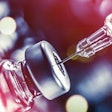
A low-cost way to diagnose COVID-19 and the flu may be in the hands of patients soon. Researchers have developed a smartphone-based loop-mediated isothermal amplification -- or Smart LAMP -- assay, paving the way for accessible infectious disease testing at the point of care, according to research published on January 28 in JAMA Network Open.
Smart LAMP is portable and inexpensive to set up (less than $100, according to the authors) and consists of a hot plate, cardboard box, and LED lights. The researchers designed the diagnostic to meet five criteria for rapid and frequent testing at the point of care: speed, sensitivity, low cost, scalability, and accessibility. The assay simultaneously analyzes up to 96 saliva samples per phone at a cost of less than $7 per test, the researchers noted.
In addition to the point-of-care criteria, the diagnostic had to match the sensitivity of the U.S. Centers for Disease Control and Prevention's guideline for the quantitative reverse transcription PCR (RT-qPCR) method, currently the gold standard for COVID-19 testing.
"The smartphone-based LAMP assay integrates reliable diagnostics with advantages of smartphone detection, offering an inexpensive diagnostic platform for SARS-CoV-2 and influenza A and B viruses that match the CDC RT-qPCR criterion standards," wrote the authors, led by Douglas Heithoff, PhD, of the department of molecular, cellular, and developmental biology at the University of California, Santa Barbara.
Another advantage of the "smart" design is that it can be adjusted for home-based testing and testing in remote and resource-limited settings, given its scalability and low cost. Unlike RT-qPCR, Smart LAMP does not require specialized equipment, accessory devices, or custom reagents.
Testing Smart LAMP on SARS-CoV-2 variants and influenza
In testing, the assay was able to detect low levels of SARS-CoV-2 and produce results in 25 minutes. The test subjects were 50 participants with no prior SARS-CoV-2 infection, 29 of whom were male.
To determine the system's sensitivity, the researchers conducted a comparative limit-of-detection (LOD) analysis of Smart LAMP versus a standard RT-qPCR diagnostic using spiked saliva samples analyzed in parallel. The LOD of the smartphone-based LAMP assay for SARS-CoV-2 was 1,000 copies/mL, matching the RT-qPCR assay in sensitivity.
In terms of specificity, the researches tested the cross-reactivity of Smart LAMP for SARS-CoV-2, SARS-CoV-2 variants, and numerous other viral and bacterial respiratory pathogens using SARS-CoV-2 primers. In each case, 100% detection was achieved.
The test successfully detected both the alpha and delta variants and can be adjusted for new evolving coronavirus variants, according to the paper.
The omicron variant emerged during the authors' manuscript review, and despite its almost 50 mutations -- most clustered in the gene encoding the spike protein -- the omicron variant "would not be expected to escape diagnostic detection of the LAMP primers described in this study," the paper asserts.
Other infectious diseases, including influenza, can be detected with the low-tech device as well. This capability will become increasingly relevant as pandemic restrictions are lifted and influenza cases begin to increase, Heithoff et al noted.
"The LAMP assay can be readily engineered to address novel CoV-2 variants and other pathogens with pandemic potential, including influenza," the authors wrote.



















